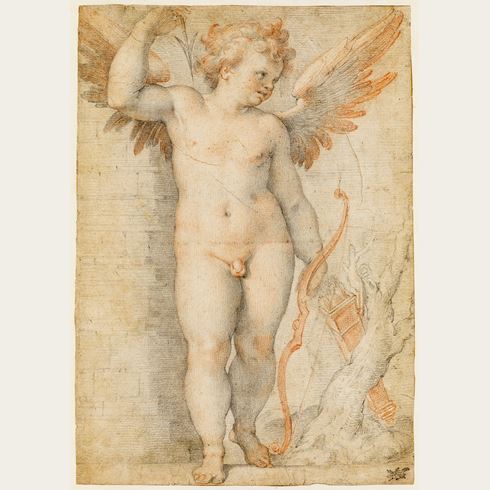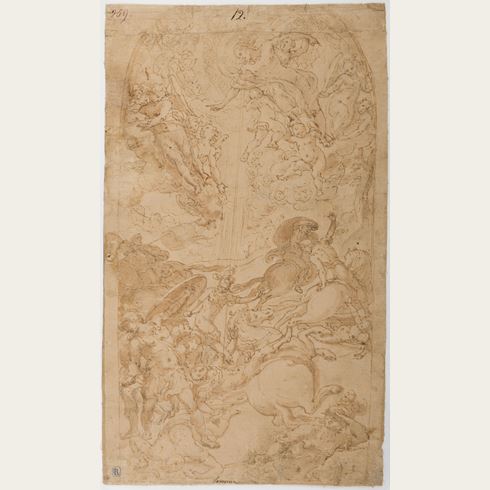Cristoforo RONCALLI
(Pomarance 1552 - Rome 1626)
A Kneeling Male Nude
Black chalk.
Inscribed R. on the verso.
A small area at the lower left corner made up.
423 x 250 mm. (16 5/8 x 9 7/8 in.)
Inscribed R. on the verso.
A small area at the lower left corner made up.
423 x 250 mm. (16 5/8 x 9 7/8 in.)
The present sheet is very closely related to a stylistically comparable study of a male nude by Cristoforo Roncalli, of similar dimensions and drawn in black chalk on blue paper, which is today in a private collection [see comparative image]. Both drawings display Roncalli’s characteristically confident draughtsmanship, with an emphasis on firm contours and a precise modelling of form achieved through the use of delicate hatching and shading with strokes of black chalk.
In his 1978 study of the artist as a draughtsman, Chandler Kirwin pointed out that ‘Roncalli appears to have had no formal training in drawing or painting during the first twenty-four years of his life…It is all the more remarkable, therefore, to observe in his earliest drawings an academic understanding of the human body and of the use of chalks to evoke three-dimensional form that one would normally expect to find in a painter who had been trained since his youth in a shop. It is quite possible that [Roncalli’s] decision to become an artist was motivated partly by the intuitive ability he possessed since adolescence to render the human form on paper. In any case, in his earliest known study Roncalli demonstrates sympathy for the nude.’ Of an early black chalk drawing of a nude by Roncalli, Chandler Kirwin notes that the artist ‘boldly builds up the flesh of the figure and responds to the subtle interaction of light falling over the skin’s surface while the elements of the nude are treated with careful attention to their naturalistic formation.’
Although the male nude in the present sheet, as well as that in the related drawing in a private collection, does not appear precisely in any extant painting or fresco by Roncalli, similarly-posed figures are found in a number of the artist’s works. In particular, a very similar pose is seen in the figure of the saint in Roncalli’s large canvas of Saint Nicholas of Tolentino Interceding for Souls in Purgatory, painted in c.1612 for the church of Sant’Agostino in Pesaro. Also somewhat similar in pose and attitude is the figure of the Virgin in Roncalli’s fresco of The Annunciation of c.1609 at Loreto.
In his 1978 study of the artist as a draughtsman, Chandler Kirwin pointed out that ‘Roncalli appears to have had no formal training in drawing or painting during the first twenty-four years of his life…It is all the more remarkable, therefore, to observe in his earliest drawings an academic understanding of the human body and of the use of chalks to evoke three-dimensional form that one would normally expect to find in a painter who had been trained since his youth in a shop. It is quite possible that [Roncalli’s] decision to become an artist was motivated partly by the intuitive ability he possessed since adolescence to render the human form on paper. In any case, in his earliest known study Roncalli demonstrates sympathy for the nude.’ Of an early black chalk drawing of a nude by Roncalli, Chandler Kirwin notes that the artist ‘boldly builds up the flesh of the figure and responds to the subtle interaction of light falling over the skin’s surface while the elements of the nude are treated with careful attention to their naturalistic formation.’
Although the male nude in the present sheet, as well as that in the related drawing in a private collection, does not appear precisely in any extant painting or fresco by Roncalli, similarly-posed figures are found in a number of the artist’s works. In particular, a very similar pose is seen in the figure of the saint in Roncalli’s large canvas of Saint Nicholas of Tolentino Interceding for Souls in Purgatory, painted in c.1612 for the church of Sant’Agostino in Pesaro. Also somewhat similar in pose and attitude is the figure of the Virgin in Roncalli’s fresco of The Annunciation of c.1609 at Loreto.
Little is known of Cristoforo Roncalli’s artistic training. Known as Il Pomarancio after his birthplace of Pomarance, he is first documented working in Siena between 1576 and 1579. During this period he painted an altarpiece for the Duomo and collaborated on the decoration of a family palazzo, and also received a commission for an altarpiece intended for the church of SS. Apostoli in Florence. Roncalli then settled in Rome, where he is recorded by 1582, and was active there for the remainder of his career. He was associated with a circle of artists active in the city that included his compatriot Niccolò Circignani (confusingly also known as Il Pomarancio) as well as Cavaliere d’Arpino, Cesare Nebbia and Paris Nogari. Roncalli received numerous public and private commissions, and was admitted to the Accademia di San Luca in 1588.
He earned a reputation as an ecclesiastic mural painter of the first rank, gaining the patronage of such Roman families as the Crescenzi, Mattei and Giustiniani, and working in the churches of Santa Maria in Aracoeli, San Giovanni Decollato, Santa Maria in Vallicella and San Silvestro in Capite in Rome. Between 1599 and 1604 he supervised the decoration of the Cappella Clementina in St. Peter’s for Pope Clement VIII, and also worked for the Pope on the decoration of the transept of San Giovanni in Laterano. Around 1607 Roncalli was named a cavaliere di christo by Pope Paul V, shortly after receiving the most significant commission of his career; the fresco decoration of the sacristy and cupola of the Basilica of the Santa Casa at Loreto, on which he worked between 1605 and 1615. On his return to Rome, Roncalli spent the last decade of his career working on more modest commissions.
An exceptional draughtsman, Roncalli worked for the most part in both black and red chalk, switching easily between them for both compositional and figural studies, although using the former slightly more in the 1580’s and 1590’s. (While a number of pen drawings by the artist are known, after the 1580’s he seems to have worked almost exclusively in chalk.) His earliest datable drawings – studies for works of the late 1570’s, as well as copies after Raphael - already show a mastery of form and line and a sophistication that would be characteristic of the artist’s drawings throughout his career. The largest extant group of drawings by Roncalli is today in the Uffizi.
Provenance
Brian Sewell, London.








 Cristoforo-RONCALLI-TheVirginandChildwithSaintAnne-1862014T184748.jpg?width=490&height=490&qlt=80&mode=pad&bgcolor=F1EEE7)

